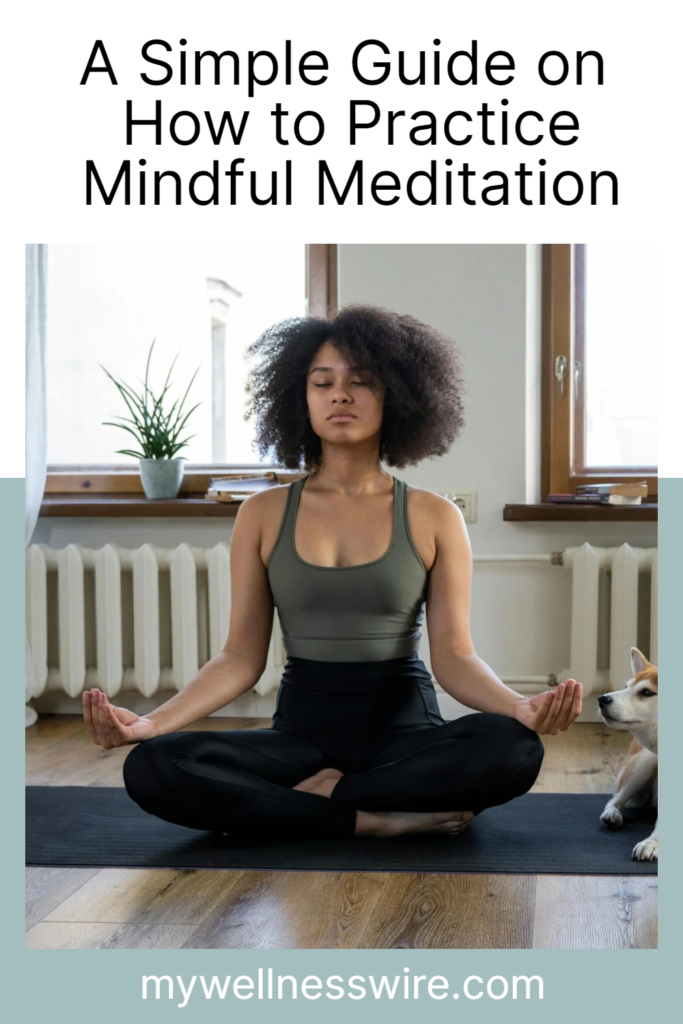
Intro
In our fast-paced society, finding moments of peace and stillness can feel like a rare luxury. Our minds are constantly bombarded with information, distractions, and stress, leaving us feeling overwhelmed and disconnected. However, there is a powerful tool that can help us find calm in the midst of chaos: mindful meditation. In this guide, we will explore how to practice mindful meditation and embrace the silence within.
Understanding Mindful Meditation and Its Benefits
Mindful meditation invites us into a practice of deep presence and gentle awareness. Thus guiding us to anchor ourselves in the now with an open heart and a non-judgmental mind.
This ancient yet timeless practice fosters a connection to the present moment, encouraging us to observe our thoughts, feelings, and bodily sensations without trying to change or resist them. By doing so, we cultivate a space of acceptance and compassion within ourselves, laying the foundation for profound inner transformation.
The benefits of engaging in mindful meditation extend far beyond momentary calm, touching every facet of our lives with their healing presence. Studies have shown that regular practice can significantly reduce stress, offering a sanctuary of peace in the midst of life’s storms.
It sharpens our focus, enabling us to navigate the demands of daily life with greater clarity and efficiency. Additionally, by teaching us to regulate our emotions, mindful meditation empowers us to approach challenges with resilience and equanimity, fostering a sense of well-being that radiates from within.
Embracing mindful meditation is also a journey toward enhanced self-awareness. As we tune into our inner experiences with kindness and curiosity, we begin to uncover insights about our patterns and behaviors. As a result, we pave the way for personal growth and self-discovery.
This path of mindfulness leads us to a deeper connection with ourselves and the world around us, in effect enriching our relationships and enhancing our capacity for empathy and understanding.
Path to Serenity: The Top 5 Best Mindfulness Books
By dedicating ourselves to the practice of mindful meditation, we invite a profound shift in how we relate to our experiences. As a result, we cultivating an inner sanctuary of calm and insight that supports us in navigating the complexities of life with grace and serenity.
Preparing Your Mind and Space for Meditation
Before embarking on your journey into mindful meditation, it’s crucial to cultivate an environment and mindset conducive to tranquility and focus. Select a quiet spot where interruptions are unlikely to break your concentration.
This place should feel safe and serene, a personal oasis where the external clamor of the world fades into the background. You may enhance this space with items that inspire peace within you, such as candles, soft lighting, or soothing scents.
3 Majestic Meditation Room Ideas: Decoding Bliss
Equally important is preparing your mind for the practice ahead. It’s essential to approach meditation with an attitude of openness and without preconceived notions of success or failure.
Release any expectations about what meditation will be like or what you should experience. Embrace the notion that this time is a precious gift to yourself, a period of stillness and introspection amidst the whirlwind of daily life.
Dedicating a consistent time slot for your practice can also significantly enhance your meditation journey.
Whether it be the gentle quiet of the morning or the calm of the evening, choose a time when you can disconnect from the demands of your day and fully engage in the practice.
This commitment to regularity helps in cultivating a ritual, signaling to your mind and body that it’s time to shift into a state of mindfulness.
As you settle into this sacred space and time, gently remind yourself that this practice is a journey. There will be days filled with ease and others where focus feels elusive.
In these moments, kindly nudge yourself back to the present. Then recognize that each second spent in meditation is a step toward deeper self-awareness and inner peace.
Basic Techniques to Get You Started
1. Position
Begin your journey into mindful meditation by settling into a comfortable position that feels grounding and supportive. Read our Guide to Meditation Poses to perfect your positioning as you progress.
2. Shift Your Attention to Your Breath
Allow your eyes to gently close, creating an intimate space for your mind to meet the present moment. Then, shift your attention to the rhythm of your breath, feeling its natural flow as it moves in and out of your body. This simple act of breathing becomes a powerful anchor to the now, helping you to forge a space of calm amid the whirlwind of thoughts and emotions.
3. Notice and Redirect Your Wandering Mind
As you dwell in this awareness, you may notice your mind drifting to past conversations, future anxieties, or any number of distractions. It’s perfectly natural for this to happen. When you observe your thoughts wandering, meet them with kindness and understanding.
There’s no need for frustration or judgment. Simply acknowledge their presence and softly redirect your focus back to the breath. This gentle act of returning to your breath serves as a practice in patience and self-compassion. Thus nurturing a mindful presence that you can carry with you beyond your meditation session.
Aim for 10 minute mindful meditation sessions when you begin your practice. As you become better at taming your “monkey mind“, begin increasing the duration of your sessions. However, it is important not to over do it as a beginner as many find themselves burn out and quite by doing so.
For those seeking a variation in their practice, consider the body scan technique. This involves directing your awareness to different parts of your body in a sequential manner, from the tips of your toes to the crown of your head. By mindfully scanning your body, you invite relaxation and a deep sense of connection to the physical self, therefore, opening doors to profound tranquility and self-awareness.
Overall, embracing these foundational practices, you step into a world where each breath is an opportunity for discovery and each moment a potential space for growth. As you continue on this path, remember that the journey of mindful meditation is as rewarding as the destination.
Incorporating Mindfulness into Your Daily Routine
Embracing mindfulness extends beyond the cushion or chair where we meditate; it weaves into the fabric of our daily lives, transforming ordinary moments into ones of deep awareness and connection. Imagine savoring every bite of your morning breakfast, feeling gratitude for the nourishment it provides.
Consider the act of walking, whether to your car or around the block, as an opportunity to connect with the earth beneath your feet and the air touching your skin. Even mundane tasks like washing dishes become a practice in mindfulness when we fully engage with the sensation of warm water and soap, the clink of dishes, and the rhythm of our movements.
By inviting mindfulness into these everyday activities, we open ourselves to the beauty of the present moment. This conscious attention enriches our day, providing pockets of peace and stillness amidst our bustling schedules.
As we cultivate this practice, we find that mindfulness is not just an activity but a way of being, one that enhances our engagement with life and deepens our appreciation for the world around us.
Let each task, no matter how small, be an invitation to return to the present, nurturing a sense of serenity that supports us through the ebb and flow of our days.
Overcoming Common Challenges in Mindful Meditation
Embarking on the path of mindful meditation can sometimes feel like navigating a labyrinth, where distractions and hurdles seem to arise at every turn. It’s important to remember, though, that these challenges are part of the journey, inviting us into deeper understanding and patience with ourselves.
A wandering mind, sensations of restlessness, or physical discomfort are common experiences that offer us the chance to practice gentle redirection and compassion. If your thoughts begin to race, or if sitting still becomes difficult, view these moments as opportunities to cultivate resilience and flexibility in your practice.
In instances where focusing feels particularly daunting, consider leaning on the support of guided meditations or joining a meditation group. These resources can provide structure and guidance, helping you to navigate the waters of your practice with more ease.
Embrace each challenge not as a setback, but as a teacher, illuminating the path towards greater self-awareness and mindfulness. Through persistence and a heart open to learning, the obstacles that once seemed insurmountable become stepping stones to a richer, more centered meditation experience.
Advanced Practices to Deepen Your Meditation Experience
As your journey with mindful meditation evolves, you may find yourself yearning to expand the depth of your practice. This is a beautiful indication of growth and readiness to explore the vast landscape of mindfulness further.
Venturing into advanced practices offers a unique opportunity to enrich your meditation experience. As a result you bring forth a deeper sense of connection and understanding to the layers of your consciousness.
One transformative approach is the practice of loving-kindness meditation, a method that nurtures an expansive heart. Here, you intentionally generate waves of compassion towards yourself and radiate this love outward, towards loved ones, acquaintances, and even those with whom you may have conflicts. This practice not only deepens your meditation experience but also cultivates an enduring sense of empathy and connection in your daily interactions.
Another profound technique is mindfulness of emotions. This practice invites you to become an observer of your emotions, without attachment or aversion. By acknowledging and allowing your feelings to be as they are, you learn to navigate the ebb and flow of emotional experiences with grace. This awareness can bring clarity and equanimity to even the most turbulent of emotions.
In sum, exploring these advanced practices can profoundly transform your meditation journey, offering new insights and a deeper, more nuanced understanding of your inner landscape. Remember, the path of mindful meditation is infinitely unfolding, inviting you to discover the boundless potential within.
Pin this post to read later



